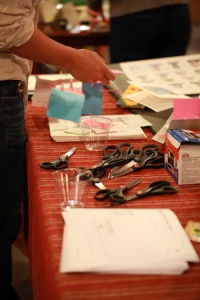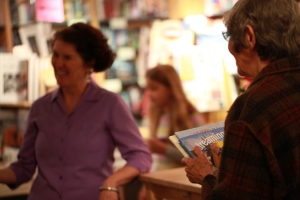![]()
![]() In her first guest post, author/illustrator Christy Hale shared ideas for how to plan a successful book launch. In her follow-up post, Hale shares tips for planning storytelling and activities for bookstore appearances. Hale is the author and illustrator of, most recently, Dreaming Up, which was named a 2012 ALA Notable Book by the American Library Association and one of the Horn Book Magazine‘s Best Books of 2012.
In her first guest post, author/illustrator Christy Hale shared ideas for how to plan a successful book launch. In her follow-up post, Hale shares tips for planning storytelling and activities for bookstore appearances. Hale is the author and illustrator of, most recently, Dreaming Up, which was named a 2012 ALA Notable Book by the American Library Association and one of the Horn Book Magazine‘s Best Books of 2012.
1. Consider the audience when planning your program. Bookstores host different types of author events. If possible attend other programs at bookstores where you will appear so you can scope out the typical crowd. The time of the event may be a good indicator of the age level likely to attend. At Kepler’s Story Time Sundays, I have read to toddlers and preschoolers with a few older school age children scattered in the mix. A mid-week morning time program at BookSmart in a shopping mall in San Jose drew in moms and caregivers with toddlers and preschoolers. An afternoon program at Linden Tree in Los Altos brought school age children. An early evening program at Reach and Teach in San Mateo was geared toward whole families. My evening launch party at Books Inc. in Palo Alto was mostly attended by adults.
2. Plan age-appropriate readings and activities. Attention span and developmental abilities vary from one age group to another.
- 2-3 year olds have an attention span of 3-4 minutes. They like repetition and imitation. They understand actions and objects.
- 4-5 years olds have an attention span of 5-10 minutes. They love fantasy and have great imagination.
- 6-8 year olds have an attention span of 15-20 minutes. They are concrete and literal minded. They can understand chronological sequence.
- 9-12 year olds have an attention span of 30-45 minutes. They like to be challenged and can learn abstract concepts.Try these ideas when reading aloud:
- Practice reading ahead of time and look for themes in your story. Make a list of questions to ask your audience (Who has seen a _____? Who likes_______?) Find areas of the story that allow for active participation.
- Be expressive! Ham it up and act it out. Enthusiasm is contagious.
- If you have a long story, feel free to skip some parts to adapt to the attention span of your group.
- Invite children to add sounds effects at select points in the story (animal noises, wind blowing, car motor, and so forth). In Elizabeti’s School, Lee & Low author Stephanie Stuve-Bodeen asks children to count to five in Swahili along with her, “Moja, mbili, tatu, nne, tano.”
- Model actions for kids to follow (Look right. Look left. Look up. Look down. Look all around.).
- Ask kids to join in repeating phrases.
- Employ props; bring show and tell. I bring a kanga from Tanzania when I read Elizabeti’s Doll.
- Use visual aids that allow for kid participation, like felt boards, large sketchpads.
3. Consider the physical space allotted for your reading and activity. Will attendees sit in chairs? On a rug? Are there tables for activities? Can attendees spread out on the floor?
4. KISS (Keep It Simple, Stupid)
- Plan activities that involve supplies the bookstore might have on hand (like glue sticks, colored crayons, pencils, and markers) OR provide your own supplies.
- Avoid activities that require water for clean up.
- Design your own activity handouts that can also serve as further promotion.
- Consider open-ended activities that allow children and adults to participate at their own developmental levels.
Here are some examples of bookstore activities I’ve designed that have been a big hit:
Dreaming Up: A Celebration of Building
- BUILD YOUR DREAMS SLOTTED BUILDING CARDS. (downloadable PDF) Materials: scissors, colored pencils, and some big dreams.
- MINI DOMES. Materials: toothpicks and gumdrops.
The East-West House: Noguchi’s Childhood in Japan
- DESIGN YOUR OWN DREAM HOUSE (downloadable PDF) Materials: printouts of PDF, pencils, and imagination. Great lesson for older kids.
- EAST-WEST KIDS COLLAGE (downloadable PDF) Materials: printouts of PDF, recycled patterned business envelopes, scissors, glue sticks, and colored markers.
Further Reading:













